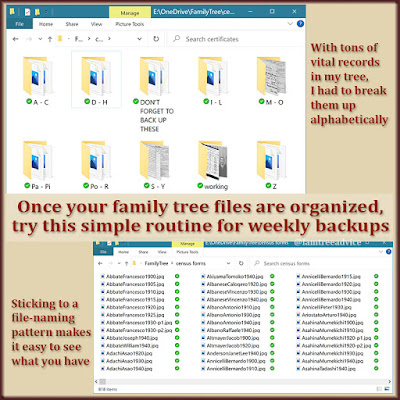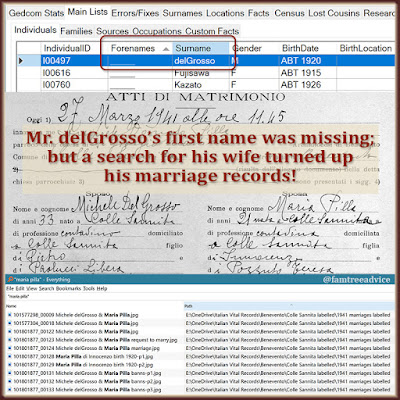It all started with Angela. When I landed on her in my 29,000-person family tree, I noticed I had her death date, but not her parents' names. She died in April 1809—about a month after my part of Italy began keeping birth, marriage, and death records.
I pulled up her death record. I found her parents' names and added them to my family tree. Then I saw a bigger problem with her father, Pasquale. His facts were a hot mess.
I found two versions of Pasquale's 1799 death record:
- in his son Angelo's 1815 marriage documents
- in his grandson Pasquale's 1853 marriage documents
In both versions of the death record, Pasquale is the son of Tommaso Cocca and Angela Gentile. That's fantastic because Tommaso and Angela are in the town's 1742 census. (The census is captured in a book called "Colle Sannita nel 1742" by my friend, Dr. Fabio Paolucci.) In both death records Pasquale's wife is Costanza Iamarino. I knew two of Pasquale and Costanza's children: Angela (born in 1776 per her death record) and Angelo (born in 1795).
But here's the problem. In my family tree, I had also identified Mariangela Iamarino as Pasquale's wife. That couple had two children in 1771 and 1773.
A note in my family tree made me wonder if he really had married both Mariangela and Costanza. Here's my note:
"Pasquale's death record (from his granddaughter Carmina Cocca's 1837 marriage documents) says he died on 2 Jul 1795, was the son of Giambattista Cocca and Pietronilla Vignogna, and was married to Mariangela Iamarino. I believe I've combined 2 men."
Finding More Facts to Sort Out the Mess
Now that I've stumbled upon this Pasquale mess again, it's time to set things straight.
The first thing to do is look at the 1795 death record in Carmina Cocca's marriage documents. In all, I found three versions of Pasquale's 1795 death record, but only one included his age at death.
 |
| Two different death records, with two different wives, made it clear I'd merged two men. |
The available facts make it clear I accidentally merged two Pasquale Cocca's into one. So how do I separate them while maintaining each man's facts?
If I could duplicate Pasquale in Family Tree Maker, I could remove the wrong facts, spouses, and kids from each man. Since there is no duplication option, I'll make a note of each fact that belongs to the Pasquale who died in 1795:
- He married Mariangela Iamarino
- They had 3 children: Giambattista, Donata, and Maria Maddalena
- I now know he died in 1795 and his parents were Giambattista Cocca and Pietronilla Vignogna
Separating the Families Carefully
To avoid losing sight of Mariangela and her children, I'll follow these steps:
- Select each of the children and detach them from Pasquale, but not from Mariangela Iamarino.
- Select Mariangela and detach her from Pasquale.
- Create a new Pasquale Cocca as Mariangela's husband and father of her children.
- Add this new Pasquale's death date and his parents' names.
With all the facts and steps in front of me, I can fix this mess without missing anything. I'll remove that very important note and bookmark from the other Pasquale Cocca, too.
Now I've given Mariangela and her children their very own Pasquale Cocca. When I added his parents, I found that they, too, are in the 1742 census. I used the census to add Pasquale's paternal grandfather and his two older siblings. Since Pasquale is not listed in the 1742 census, I know he was not born in 1740, as his death record says. I'll give him a birth date of Abt. 1743.
Don't Assume You'll Remember These Things
I'm so grateful I left myself a note about Pasquale.
 |
| The Bookmarks feature of Family Tree Maker is an important way to keep your notes visible. |
When I add a note in Family Tree Maker, I give the person a bookmark. Seeing that bookmark in the list of all people lets me see there's something about this person I need to know. Once I solve a problem, I remove the note and the person's bookmark.
If there's a hot mess in your family tree, gather as many facts as you can. Pay attention to the discrepancies. Take careful notes so you can undo your errors and set things straight.

















